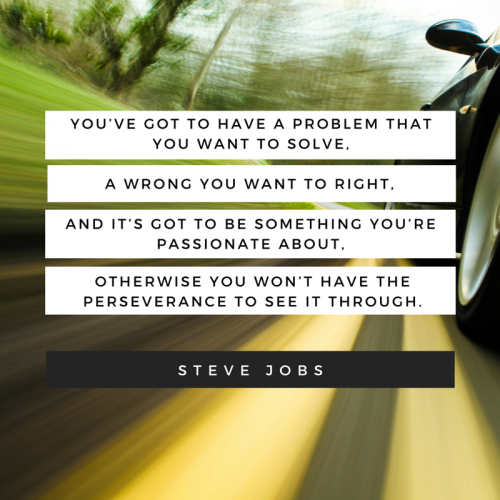GPS for Leading Change
Navigating Change (After the Show)
If you and your team have attended one or both of the automotive marketing conferences this October, you might be trying to decide how to make that investment of time and resources count. Maybe you’re considering implementing a new system, or even just a set of new ideas or processes, at your dealership. Where do you begin? How do you quickly get leadership and employee buy-in? What’s the best way to communicate changes in workflow or process? These are just a few of the questions you’ll want to ask in order to lead change effectively.
It is impossible to maintain the high of the show once you’re back to the grind, so you’ll be tempted to move quickly and capitalize on any momentum your team has going. But smart leaders know it is wise to step back and re-evaluate your new ideas in the daylight of reality. But how do you keep from losing your passion? It starts with trusting what you know for sure. If you have done the work to clearly define the mission of your dealership, and communicated it to everyone working in your dealership, you are more than half way there. One of my favorite Steve Jobs quotes brilliantly describes what a successful movement requires. “You’ve got to have a problem that you want to solve, a wrong you want to right, and it’s got to be something you’re passionate about, otherwise you won’t have the perseverance to see it through.”
Culture Precedes Change
What is your dealership passionate about? Selling cars, of course…right? That is, after all, what keeps the lights on and the checks from bouncing; but you need to go deeper to tap into the mojo required for effectively leading change. How is the problem you want to solve, or the wrong you want to right, connected to the mission and vision of your dealership? Have you clearly defined the reason behind the “what” you do every day? Without absolute clarity about the problem you are [passionately] trying to solve, change will always be difficult, because with that clarity comes purpose, and purpose makes change simple. [Notice I didn’t say easy.] With purpose, you know instantly when something new makes solving the problem you’re trying to solve, easier. And this knowledge creates the will to change, and the passion to make it stick.
Defining the Problem You Solve
A while back my team created a culture map for dealerships who want to get clear about their mission. You can download it here. If you’re getting ready to lead change, I’d encourage you to take the time to complete the culture map, or something similar, and get clear on the answers to those questions in your own mind. Answering them will do one [or more] of three things: One, you’ll affirm the reasons you believe this change will bring you closer to delivering on your customer promises, two, you’ll discover the big idea you wanted to implement doesn’t help you solve the problem you’re solving more effectively, and/or three, you’ll realize you’ve got some other work to do first.
Culture, Then Market
Once you are sure you’ve done the cultural groundwork for implementing change and feel certain the change is right for your dealership culture, get your data ducks in line. Every single change you make to processes and workflow should seek to improve customer experience. Customer Experience [employees are customers, too] is the battleground for the modern dealership. A recent Gartner survey found that, by 2016, 89% of companies expect to compete mostly on the basis of customer experience, versus 36% four years ago. [Read that again.] Those numbers should be sobering to folks in every industry, especially automotive. Customers are increasingly demanding a certain kind of experience from every brand, and competition is fierce. The day has come when knowing what your customers expect, and successfully meeting or exceeding those expectations, should be the focus of every strategy and message from your brand.
Gone are the days of our parents and/or grandparents who bought every single car from the same guy, and then that guy’s son, for more than 60 years. In their day, people chose an OEM sort of like they chose a political party. If you are GenX and older, you’ve likely heard someone in your family say, “We’re a Ford family”, or “We only buy General Motors”, and you’re likely to remember a time when your automotive dealer was in the same category as your family doctor,dentist, etc…he was your guy. And that made sense in a non-digital world, because time has always been money. Dealers today have a whole different set of challenges. They have to compete for every sale, and discover how to effectively engage customers. Every change at your dealership must not only fit your dealership culture; they need to make sense for today’s market. Once you’ve affirmed the change is a cultural fit and makes sense, you’ll need to decide how to measure success.
Market, Then Data
It’s a given that most changes to your dealership sales process, strategy or workflow will include changes to your marketing approach. After all, in order to sell more cars, you need to reach more in-market customers, right? Doing your homework is the only way to be certain your efforts will result in more opportunities to sell. Automotive dealerships have one of the highest customer acquisition costs, so your decision-making must be data-based and do-able. Your CRM is where your eCommerce and sales team work every day. If customer experience wins the sale, it makes sense for dealerships to be as strategic as possible about adding more data to the pipeline. So, think strategically. For example, maybe you don’t need more lead sources, you just need betterones, or better access to the ones you already have.
Strategy anchors data and makes it useful. Customer experience begins with the right message at the right time. A recent report from McKinsey & Companyrevealed the significant advantage brands have over competitors when they are able to adapt and respond quickly to the needs of consumers. Those micro-moments are where customer experience lives or dies. And, overwhelmingly, research points to the increasing power of your employee advocates for effective marketing. Click here to read an article I wrote called “The Power of One”, with some of the best research on the effectiveness of employee advocacy.
 Free Advice on Change That Will Work
Free Advice on Change That Will Work
When you leverage the reach of employees, you effectively take your showroom online, where your customers are shopping, increasing your chances of connecting with more in-market customers with credible messaging. But how will that information make its way to your CRM where you can use it? If you’re dealership has FuzeCast, you are able to measure the reach of individual employees [in dollars and cents] and gamify brand advocacy to unify your culture and reward top performers. Add ProfileFuze to the mix, and you become a lead generation machine; delivering online shopping insights-and taken to the next level by your employees advocates. ProfileFuze reveals research behaviors, social connections to your dealership and more, right to your CRM in the form of leads. Active-shopping-make-model comparing-ready-to-buy-a-car, LEADS!
Change should make a difference in the lives of your employees and your customers. The right changes will motivate your employees, and make it easier for them to deliver an exceptional customer experience. Your team will get behind changes that help them connect with customers more effectively. When employees feel valued and connected to the story of your dealership, they become partners with you. And when you reward their commitment, they stay engaged in the process of growing your brand. This is what smart marketing in the age of big data looks like.
© 2026 Created by DealerELITE.
Powered by
![]()

You need to be a member of DealerELITE.net to add comments!
Join DealerELITE.net